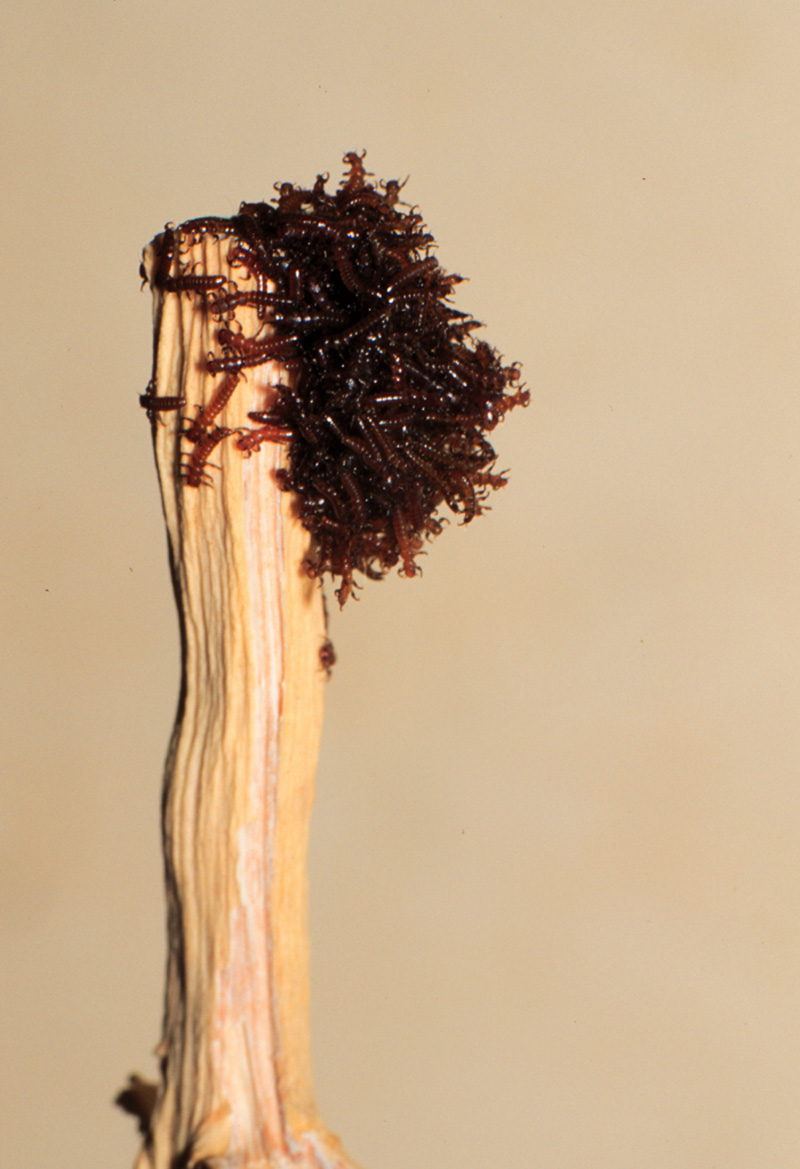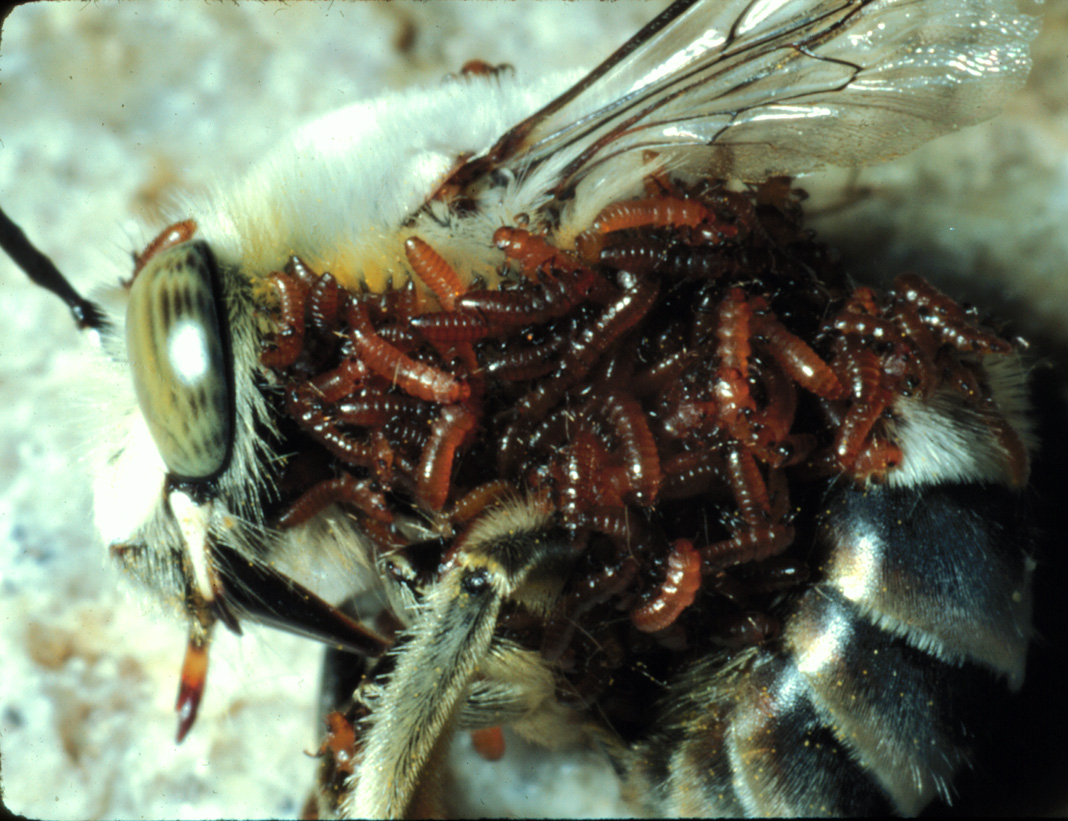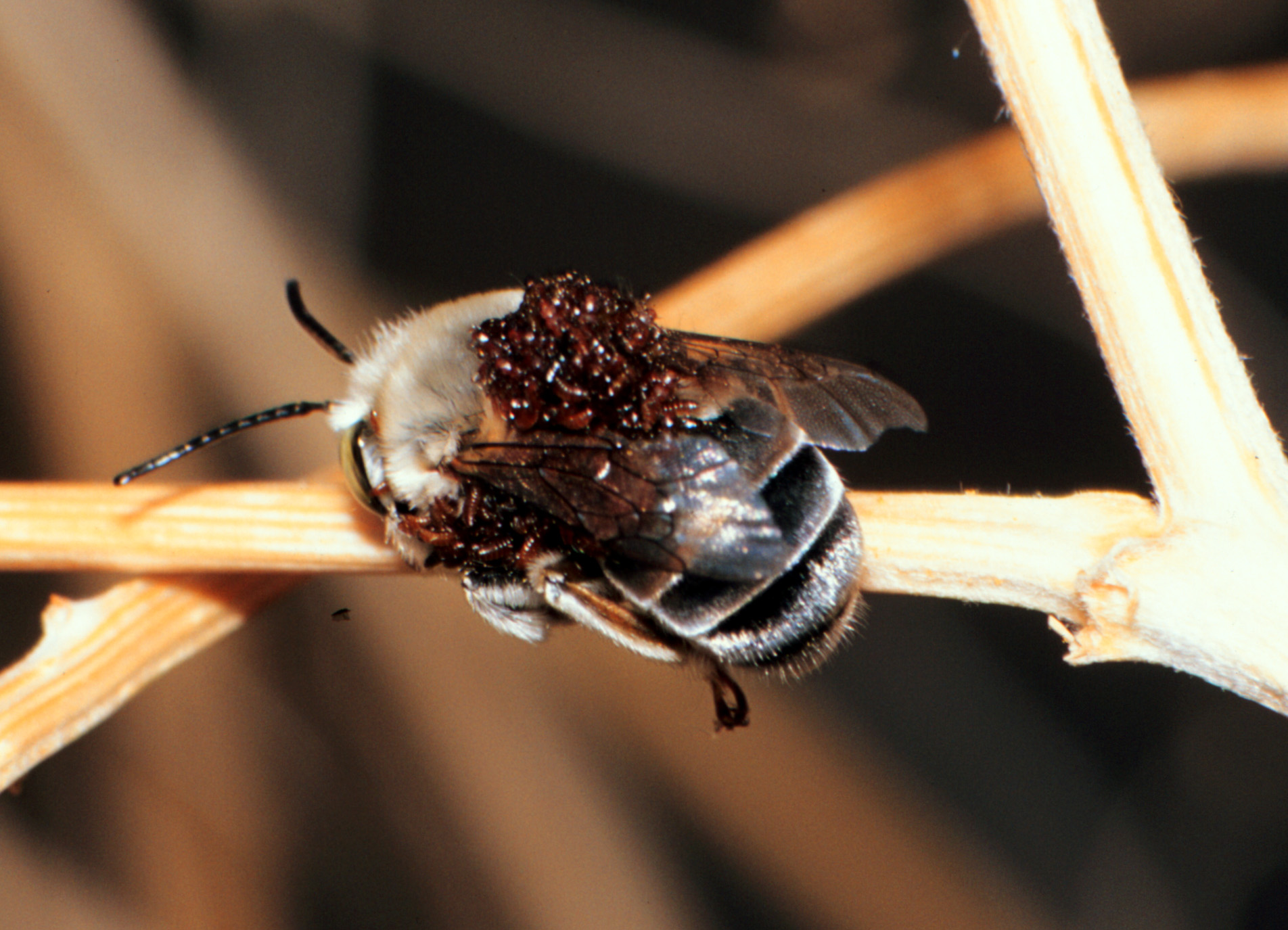
College
of Science & Engineering Alumni Newsletter
Fall
2000
"Spanish Fly” Beetles Use Sex and
Subterfuge to Infiltrate Bee’s Nests
Researchers document
the first case of parasitic insects cooperating to mimic
the appearance, and
perhaps scent, of their female hosts
The
Kelso Dunes, located halfway between Barstow and Las Vegas in the Mojave
National Preserve, is an unlikely setting for a soap opera. But the springtime
behavior of blister beetles puts the daily machinations of daytime television
stars to shame.
In
what San Francisco State University researchers say is a “remarkable mode
of host-finding,” newborn blister beetle larvae of the species Meloe franciscanus
mimic female bees as part of a three-step strategy to infiltrate and parasitize
the bee’s nest. Much like Chinese parade dragons, which require numerous
individuals working cooperatively to form the illusion of a single animal,
blister beetles likewise pull off their charade. According to SFSU Biology
Department Chair Dr. John Hafernik and graduate student Leslie Saul-Gershenz,
this is the first reported instance of parasitic larvae cooperating to
mimic female host species. The two researchers presented their findings
last spring in the journal NATURE.
 Upon hatching from their sandy burrow, hundreds of these dark-orange beetle
larvae, called triungulins, navigate their way to the tip of the nearest
plant stem, where they form wriggling masses, or aggregations, that roughly
resemble—and likely smell like—female Habropoda pallida bees.
Upon hatching from their sandy burrow, hundreds of these dark-orange beetle
larvae, called triungulins, navigate their way to the tip of the nearest
plant stem, where they form wriggling masses, or aggregations, that roughly
resemble—and likely smell like—female Habropoda pallida bees.
“While
cooperative behavior is common among highly social insects, such as bees
and ants, it has never been reported in blister beetles. What’s more, until
now, no other insect has been known to use cooperative behavior to mimic
other species,” says Hafernik, who along with Saul-Gershenz documented
this behavior during the springs of 1992 and 1999 from the CSU Desert Studies
Center.
According
to the researchers, once the triungulin mass successfully lures a male
bee into pseudocopulation, the larvae use pincher-like limbs to attach
themselves to the underside of the duped male, who deposits the larvae
on female bees during further mating attempts, called venereal transmission.
“By
first attaching to a male bee, triungulins have access to multiple females
and subsequently the multiple nests of each female,” says Saul-Gershenz. 
The
female bees then unwittingly transport these larvae back to their nests,
which they’re busy provisioning with pollen and nectar for their
own eggs. “Once inside, the larvae parasitize the nest,” says Hafernik.
“The provisions that would have produced a bee produce a beetle instead.
Bee eggs already in the nest cell are likely eaten by the larvae as well.”
Blister
beetles are named for their defensive mechanism of releasing a drop of
bright-orange blood laced with the chemical cantharidin, which causes severe
pain and blistering upon contact with the skin. This substance is also
used in the dubious aphrodisiac “Spanish Fly,” which, when ingested, causes
severe burning in the urinary tract.
The
researchers believe the aggregations lure males into pseudocopulation through
a combination of visual and olfactory cues. They noted that triungulin
masses position themselves on vegetation much like female bees—perched
on the top of a plant stem—and males approach and land on masses and females
in the same way. To test for the possibility of olfactory cues, the researchers
placed fake aggregations near live aggregations that were formed or in
the process of forming. 
“The
male bees ignored the models completely but hovered or tried to land on
groups of triungulins even before they were formed into a bee-like mass,”
says Saul-Gershenz, who is currently studying the chemical cues. “The triungulins
are likely emitting a bee-like pheromone to attract males, and another
chemical cue to form aggregations.”
During
their field survey, the researchers observed the life cycle of 22 masses,
noting 98 instances of bees hovering within a few centimeters of a triungulin
aggregation and nine instances where bees landed on aggregations.
Researchers
have long known that many blister beetle species parasitize bee nests,
but never made the connection between triungulin aggregations—first reported
in 1895—and nest finding. Aggressive mimicry is not new, but has
only been associated with individuals of a species. The Ophrys orchid mimics
the appearance and scent of female bees to attract pollinators to its flower,
and female bolas spiders attract prey by mimicking the female sex pheromone
of the armyworm.
Dr.
Ronald McGinley of the Smithsonian Institution’s Department of Entomology
says the findings raise “exciting questions” for future research. “How
do newborn beetle larvae coordinate a collective pilgrimage to individual
grass stems? And why is this particular bee species attracted to ‘larval
clumps’? Is the attraction visual, chemical or both? We can look forward
to these researchers revealing some of these answers in future work.”
Captions:
1. Triungulins aggregated
on a dried twig
2. Male bee with triungulins
onits underside
3. Female bee with triungulins
on its back
Back
to Newsletters
SFSU
: College of Science &
Engineering : Featured
Sites : Home
Updated by Lannie
Nguyen-Tang on June 27, 2001

 Upon hatching from their sandy burrow, hundreds of these dark-orange beetle
larvae, called triungulins, navigate their way to the tip of the nearest
plant stem, where they form wriggling masses, or aggregations, that roughly
resemble—and likely smell like—female Habropoda pallida bees.
Upon hatching from their sandy burrow, hundreds of these dark-orange beetle
larvae, called triungulins, navigate their way to the tip of the nearest
plant stem, where they form wriggling masses, or aggregations, that roughly
resemble—and likely smell like—female Habropoda pallida bees.

